The Fate of Frey by Bluetiger
Originally published in the Polish language at FSGK PL as Taniec z Mitami: Przeznaczenie Freya (https://fsgk.pl/wordpress/2019/09/taniec-z-mitami-przeznaczenie-freya/)
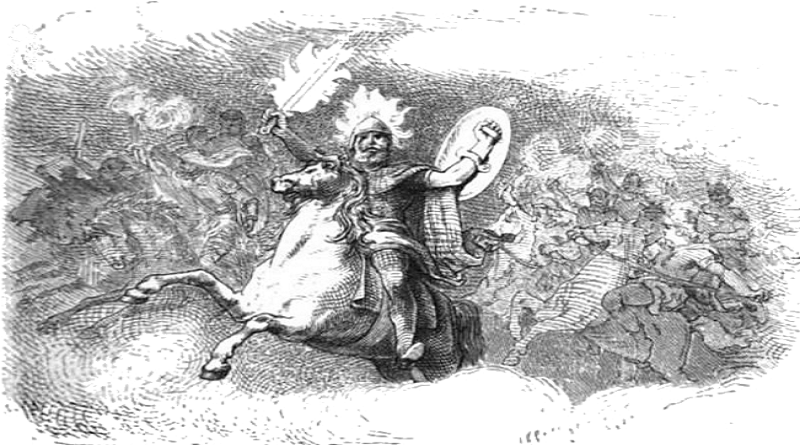
The last time we saw him, a blizzard forced Stannis Baratheon to halt his march on Winterfell and make camp in an abandoned crofters’ village by an ice-bound lake, some three days away from his destination. Against his army, made up of knights and men-at-arms who have accompanied the claimant from the South, and warriors of the mountain clans, two hosts have been dispatched by Roose Bolton. The first of those is led by Lord Wyman Manderly, while the second consists of Freys, aiding the Lord of Dreadfort in subjugating the North, in accordance with their alliance pact sealed before the Red Wedding.
The contingent from the Twins was led by Lord Walder’s third son, Ser Aenys Frey, until a clever trap set by Stannis’ ally Mors Umber caused his demise. In this situation, the command of the Frey detachment passed to Walder’s sixth son, Hosteen.
Although Ser Hosteen is a battle-hardened warrior, it would appear he finds following orders much easier than giving them. Stannis’ opinion about the knight’s abilities is rather unflattering, and he goes as far as to name him “Ser Stupid”. To make matters even worse (at least from the Frey point of view), Hosteen is an impulsive man and lacks the restraint (and calculatedness) which characterizes some of his kin.
When a series of suspicious deaths begins in Winterfell, Hosteen makes it no secret that he believes Manderly is the culprit. He has no doubts that lord Wyman was involved in the enigmatic disappearance of three Freys (Jared, Symond and Rhaehar) traveling from the White Harbor to Winterfell either. Following Little Walder’s murder, Hosteen publicly puts the blame on Manderly, who denies such allegations, but declares that perhaps the youth’s death was a blessing – “had he lived, he would have grown up to be a Frey”. Hearing those words, the future commander of an entire army can’t help but to allow himself to be provoked, and attacks the Lord of White Harbor, only to be stopped by Manderly’s knights.

House Frey coat-of-arms by Abjiklam
To prevent future disputes within Winterfell’s walls, and dispose of bothersome allies (at least one of whom can be strongly suspected of being disloyal), Roose Bolton sends the Freys and the Manderlys against Stannis. However, due to aforementioned animosity between the two houses, their forces set off separately (which is quite beneficial for Wyman, if he really has plans to switch sides, and also suspiciously convenient for Mors Umber, since only the Freys fall into his trap). Thus, Ser Hosteen and his men will have to face Stannis Baratheon on their own.
***
What will be the result of this engagement? Many a theory has been written about this incoming battle, known as the Battle of Ice, but this time, we will turn to Norse Mythology, where – as I believe – some hints about our Frey’s fate can be found.
Much can be said about the influence those tales had on George R.R. Martin’s works. From Dreamsongs we know that the writer has read the Eddas (the older Poetic Edda and the younger Prose Edda) and some of the Icelandic Sagas.
My major was journalism, but I took a minor in history. My sophomore year I signed up for the History of Scandinavia, thinking it would be cool to study Vikings. Professor Franklin D. Scott was an enthusiastic teacher who invited the class to his home for Scandinavian food and glug (a mulled wine with raisins and nuts floating in it). We read Norse sagas, Icelandic eddas, and the poems of the Finnish patriotic poet Johan Ludvig Runeberg. I loved the sagas and the eddas, which reminded me of Tolkien and Howard.
—George R.R. Martin, Dreamsongs—
Today we fill focus on a certain event which takes place during the end of the world (at least as we know it) described in the Eddas, when the destiny of the gods will be fulfilled, and Asgard and all the other worlds, including Midgard, will be destroyed in fire. This final battle between the forces of good and evil will is known as Ragnarök, which means “the fate of the gods” or “the destiny of the gods”. Due to an error in translation of this Old Norse term, there exists a second term for this Doomsday – the Twilight of the Gods (Götterdämmerung), made well-known in a large part because of Richard Wagner’s music drama The Ring of the Nibelung.
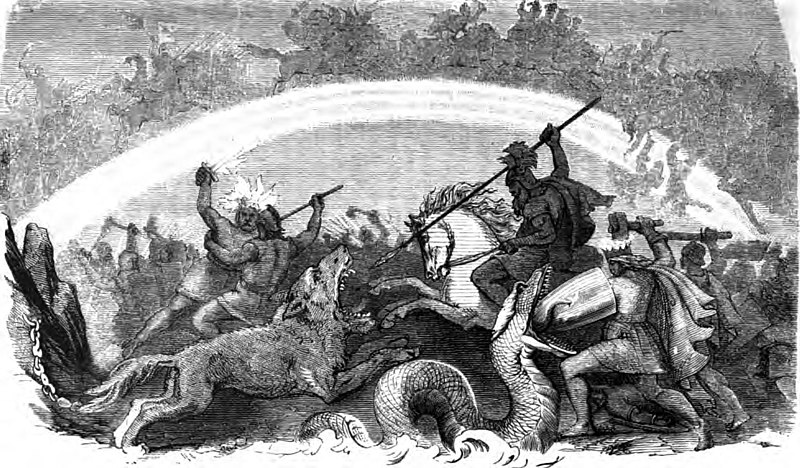
Friedrich Wilhelm Heine, Battle of the Doomed Gods An artistic vision of Ragnarök (Wikimedia Commons)
In A Song of Ice and Fire we find many references to events heralding Ragnarök and taking place during it, such as: the terrible winter (Fimbulvinter) lasting for three years, the swallowing of the sun and the moon by the wolves named Sköll and Hati, the Iron-holt (Iron-wood) Járnviðr¹, the hound Garmr belonging to the goddess Hel, the horn-blowing Heimdall, the three crowing roosters, Valhalla, Tyr and Fenrir, Odyn and his ravens, the World Tree Yggdrasil, the Midgard Serpent Jörmungandr… influences from other myths can also be discerned (it is worth to mention, for instance, the valkyries, the undead draugr, Loki, Iðunn and her apples, the tale about Baldur’s death inadvertently causes by the blind Höðr).
| ¹ Simplifying, ð is pronounced in a similar way to th in words like father and that. |
All those connections are a fascinating topic, one to which we will surely return in the future. However, in this essay, I wany to primarily bring to your attention one event and two heroes.
In order to do so, we have to reach out to the Poetic Edda, which begins with the poem Völuspá, which can be translated as The Prophecy of the Völva or The Prophecy of the Seeress. According to beliefs of the pre-Christain Indianina, a völva was a person whom we could also call a prophetess, a foretelling woman or a seeress (think of seer, on the basis of which GRRM has created his greenseer term). It is curious that another word for a völva is vala (in fact, Völuspá sometimes appears as The Prophecy of the Vala) – perhaps this is where GRRM got the name Val from. After all, the ASOIAF Val might be, in a way, a priestess of the old gods, and it also appears that the author intentionally contrasts her with Melisandre, a believer of the fire god.
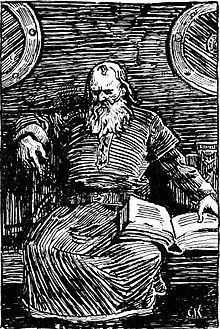
Christian Krohg, Snorri Sturluson – author of the Prose Edda (Wikimedia Commons)
In the poem Völuspá a certain völva is asked by Odin to present the history of the world, beginning with its creation and finishing with its end, Ragnarök. Here we are mainly interested in one event in the final battle between the gods (Æsir and Vanir) and the giants.
According to the seeress’ words, among portent revealing that the end is near will be the following events: a witch living in Járnviðr (Ironwood) will give birth to two offspring of Fenrir the wolf, Sköll and Hati, who shall steal the sun and snatch the moon from the firmament; three roosters shall crow – the golden Gillinkambi in Valhalla, the crimson Fjalar in Jotunheim, and the unnamed soot-red rooster in Hellheim; the infernal hound Garmr guarding the entrance to the realm of the dead will howl and fetters binding him shall burst.
There will come a time when:
Brothers shall fight and fell each other,
And sisters’ sons shall kinship stain;
Hard it is on earth, with mighty whoredom;
Axe-time, sword-time, shields are sundered
Wind-time, wolf-time², ere the world falls;
Nor ever shall men each other spare.
—From Henry Adam Bellows’ translation of Völuspá in The Poetic Edda—
| ² Perhaps this is why GRRM originally wanted to name one of the ASOIAF novels A Time for Wolves. |
Then Heimdall, guarding the rainbow bridge Bifrost, which connects Midgard (lands inhabited by humans) with Asgard (realm of the gods), shall blow his horn Gjallarhorn. When it sounds, the World Tree Yggdrasil will shiver. The giant Hrym will come from Jotunheim, bearing a shield. The serpent Jörmungandr, surrounding Midgard, will writhe, arousing enormous waves. The ship Naglfar will sail on this turbulent sea, carrying Loki and his host of monsters and giants.
Another enemy of the gods who will arrive is Surtr, a giant coming forth from Muspelheim (realm of fire) the south. His flaming sword will shine brighter than the sun.

John Charles Dollman, The Giant with the Flaming Sword (Wikimedia Commons)
During Ragnarök the gods – and their allies, mortal warriors who were slain in earlier battles and whose souls were carried to Valhalla by the valkyries, to await this one last fight – will stand against the forces of evil. According to the Prose Edda, which was written by Snorri Sturluson (12th and 13th century Icelandic poet and historian descended from the influential Sturlung clan), the Rainbow Bridge Bifrost will collapse when giants from Muspelheim, led by Surtr, will cross it.
Odin will sally forth with warriors of Valhalla to face the monstrous wolf Fenrir, and will be devoured by him. Vidar will avenge his father’s death. The one-handed Tyr (who has sacrificed his limb so the gods could capture Fenrir) will fight goddess Hel’s dire hound Garmr – the adversaries will kill one another. The result of Heimdall’s duel with the treacherous Loki will be similar. Thor’s destiny will be to combat Jörmungandr, and he will manage to slay the beast, but won’t leave long enough to boast of it – he will perish, poisoned the Midgard Serpent’s venom. Freyr will stand in the way of the giant Surtr (brandishing the shining sword, as bright as the sun), but won’t manage to overcome him and will fall dead. At the very end, Surtr will use his weapon to engulf the entire world in flames. Thus the destiny of the gods will be fulfilled.

John Bauer (1882 – 1918), Tyr and Fenrir (Wikimedia Commons)
***
I suspect that when George R.R. Martin created a scenario where, in the Battle of Ice, Stannis Baratheon and Hosteen Frey become adversaries, he has this very scene with Surtr and Freyr in mind.
The surname “Frey” is most likely a reference to “Freyr” (whose name is often anglicized as Frey). The mythical Frey was one of the Vanir, the elder group of Norse deities, which was supplanted by the Æsir led by Odin. As it was described in Philip Parker’s book The Northmen’s Fury: A History of the Viking World, according to some researchers, the merger of two pantheons (Æsir & Vanir) might suggest that two distinct peoples, worshiping different gods, were united. There are also theories that the Scandinavians originally worshiped the Vanir, deities associated with fertility and prosperity, and only later did the Odinic cults develop (it seems this god rose to prominence in the Vendel Period – between roughly 550 and 790 AD – shortly before the Viking raids began).

Johannes Gehrts, Freyr (Wikimedia Commons)
Be it as it may, Freyr was the god of fertility and virility. His twin sister was Freya, goddess of love. Their parents were Njörðr, protector of the sea, sailors and fishermen, but also god of winds; and (at least in some accounts) Skaði, goddess of skiing, mountains, winter and hunting.
Just like Freyr, House Frey (and especially its patriarch, Lord Walder) is famous because of its fertility. We may see another parallel if we look at the god’s steed, the golden boar Gullinbursti, whose bristle glowed in the dark. Actually, Ser Hosteen also has a connection with with animal. To find out how this parallel works, we have to simply look at the sigil of the house his mother Amarei Crakehall came from.
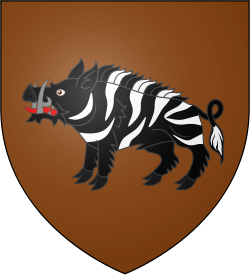
House Crakehall coat-of-arms by Abjiklam
***
As for Stannis and Surtr, the obvious similarity between the two is the flaming sword – Lightbringer is described in a way reminiscent of the fiery giant’s weapon. What is more, in some scenes George R.R. Martin appears to be using the same phrase as Snorri Sturluson in Prose Edda. Just like Surtr’s blade, Stannis’ sword is compared to the sun:
Stannis Baratheon drew Lightbringer. The sword glowed red and yellow and orange, alive with light. Jon had seen the show before … but not like this, never before like this. Lightbringer was the sun made steel. (…)
Lightbringer was brighter than I’d ever seen it. As bright as the sun.” Jon raised his cup. “To Stannis Baratheon and his magic sword.”
—A Dance with Dragons, Jon III—
In Rasmus Björn Anderson’s translation of Gylfaginning from the Prose Edda we read that:
In the midst of this clash and din the heavens are rent in twain, and the sons of Muspel come riding through the opening. Surt rides first, and before him and after him flames burning fire. He has a very good sword, which shines brighter than the sun. As they ride over Bifrost it breaks to pieces, as has before been stated.
—Prose Edda by Snorri Sturluson, translated by Rasmus Björn Anderson—
Just like Surtr, Stannis came from the South, while his seat – the volcanic isle of Dragonstone – is a place which we can call a realm of fire, just like Muspelheim, the jötunn’s home. In Iceland, there exists a complex of lava caves, which must have reminded the locals of the fire giant’s domain, as they gave it the name of Surtshellir (Surt’s Cave). In the middle ages, outlaws used the cavern as their hideout, but according to long-persistent folk beliefs, in ancient times it was Surtr himself who lived there. I don’t know if George R.R. Martin heard about this place, but at the very least, its name demonstrates how Icelanders imagined the seat of the Lord of Múspell – and Dragonstone is quite similar to such a vision.
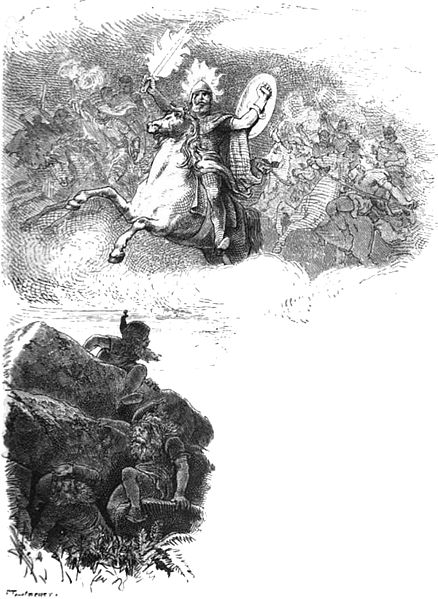
Friedrich Wilhelm Engelhard, Surtur mit dem Flammenschwerte – Surtr with a flaming sword (Wikimedia Commons)
Is Stannis a giant? Well, the Baratheons are famous because of their height, and in A Game of Thrones Robert is described as a “veritable giant”. Is this enough to determine that his younger brother is another giant, which would strengthen a thesis about his connection with Surtr?
It just so happens that in A Dance with Dragons there is a scene where something curious happens to Stannis’ shadow, when the Wildlings who want to pass to the other side of the Wall are forced to burn weirwood branches:
They came on, clutching their scraps of wood until the time came to feed them to the flames. R’hllor was a jealous deity, ever hungry. So the new god devoured the corpse of the old, and cast gigantic shadows of Stannis and Melisandre upon the Wall, black against the ruddy red reflections on the ice.
—A Dance with Dragons, Jon III—
This quote comes, funnily enough, from the very chapter where just after “Mance Rayder” is burned and just before the Wildlings cross to the southern side of the Wall, Lightbringer suddenly shone brighter than ever before, becoming “the sun made steel”. Jon’s third chapter in ADWD is a place where we find an unusual concentration of Norse Mythology references: Tormund (Thor), the Horn of Joramun (Jörmungandr), Ygritte (whose name most likely comes from Yggdrasil, and perhaps contains the word “rite” as well), Val (vala, or völva, a priestess and a seeress) and Sigorn (perhaps Sigurd, and even if this is not the case, the name still has a Norse ring). Perhaps Stannis (his shadow) as a giant is another of those, foreshadowing his future role as Surtr fighting the Freys.
To crown it all, the Wall itself can be seen as a symbol of the Rainbow Bridge. We can do so because of descriptions such as this, coming to us from Jon’s eleventh chapter in A Dance with Dragons:
Outside the day was bright and cloudless. The sun had returned to the sky after a fortnight’s absence, and to the south the Wall rose blue-white and glittering. There was a saying Jon had heard from the older men at Castle Black: the Wall has more moods than Mad King Aerys, they’d say, or sometimes, the Wall has more moods than a woman. On cloudy days it looked to be white rock. On moonless nights it was as black as coal. In snowstorms it seemed carved of snow. But on days like this, there was no mistaking it for anything but ice. On days like this the Wall shimmered bright as a septon’s crystal, every crack and crevasse limned by sunlight, as frozen rainbows danced and died behind translucent ripples. On days like this the Wall was beautiful.
—A Dance with Dragons, Jon XI—
Considering that, as we have just established, Stannis symbolizes Surtr, and according to the Prose Edda a host led by the giant will cause Bifrost to collapse, the image we begin to see is sinister. Will Stannis play some role in the Wall’s downfall?
Since Ser Hosteen is Freyr’s counterpart, and Stannis is a Surtr analogue, we should suspect that the Baratheon and his men will succeed in defeating the Frey army in the battle of the crofters’ village. If the scenario DaeL has plotted out in one of his Wild Theories (Szalone Teorie), GRRM will recreate the myth quite thoroughly. If Hosteen leads his men in a charge over the frozen lake, and if the ice breaks under them, we will get out shattering Bifrost. And if Stannis makes use of the trick used by the pirates of the Three Sisters, luring the Freys onto the lake, while the king himself will be safely positioned on an isle, and in the crucial moment of the charge will use Lightbringer to blind his enemies – well, GRRM’s Freyr will die because of Surtr’s sword brighter than the sun, just like his mythical predecessor.
And even if the events of The Winds of Winter won’t unfold exactly in this way, when Stannis Baratheon and Hosteen Frey face one another in battle, the pattern established by Snorri in the Prose Edda will still be fulfilled. The Freys will live to see their own Ragnarök.
Thanks for reading, I hope you’ve enjoyed this piece
Yours, Bluetiger
***
maiden with a clear connection with Ghost (Jon’s fylge), and her coloring is very icebear/swan/Viserion-like (white and honey/gold). She is assoiciated with winter without being a Night’s Queen/Hell-figure, I think – her eyes are either grey or blue, but her face is always described as flushed and alive-looking. No real Other/dead of winter-symbolism.
Melisandre, on the other hand, is definitly a Vala/Vølve, she can perform Sejd-magic and proficise, so I think it could be in this aspect that she is contrasted to Val. Fire-vølve vs. Ice-valkyrie. What do you think about that?
Regarding Freyr, I like this Ragnarok scenario, (even though I do not like the Frey’s representing Freyr, because they are shit people) and there is no doubt in my mind that you prediction of the outcome of the Battle of Ice outside Winterfell will follow the Frey/Surt scenario from the last battle of the gods. Interestingly, etymological versions of “surt” means “sour”, “ill-tempered”, “joyless” in several Nordic languages ☺️ The shoe really fits for Stannis.
My favorite mystery of Freyr, however, is his animated sword that can fight on it’s own and which was given to Freyr’s servant Skirnir (“Bright one”) so he can go to Jotunheim and woo Gerd on Freyr’s behalf. Apart from the whole horrible “usurping” of Gerd, Freyr’s sword (the one I like to call Summarbrand 😉) was gifted to Skirnir as payment for the task. I have read speculation that Surt’s sword ”bright as the sun” could be that same sword, adding to the irony of Freyr being slain with his own sword. I have seen Surt’s sword called “Lævitan” (not in the islandic texts, in other sources), some have likened it symbolically to the Sun itsself (sometimes his sister/twin/consort Freya is also the Sun), and this is the main basis for reasoning that Summarbrand = Lævitan = the sun. It will be swallowed by one of the wolves, and then reborn.
I think these ideas could really be in tune with GRRM’s mythological astronomy-angle. Stannis the fiery Night’s King will defeat the Freys (Summer/good weather/crops/fertility) with the fiery Sun-sword and then the “once chained, now flying” winged wolf Bran will take the sword/Sun/his sister from him, extinguishing his destructive power and making way for the Sun’s rebirth (Spring).
In this symbolic case, Stannis’ sister/twin/consort would be Melisandre, of course.
LikeLiked by 1 person